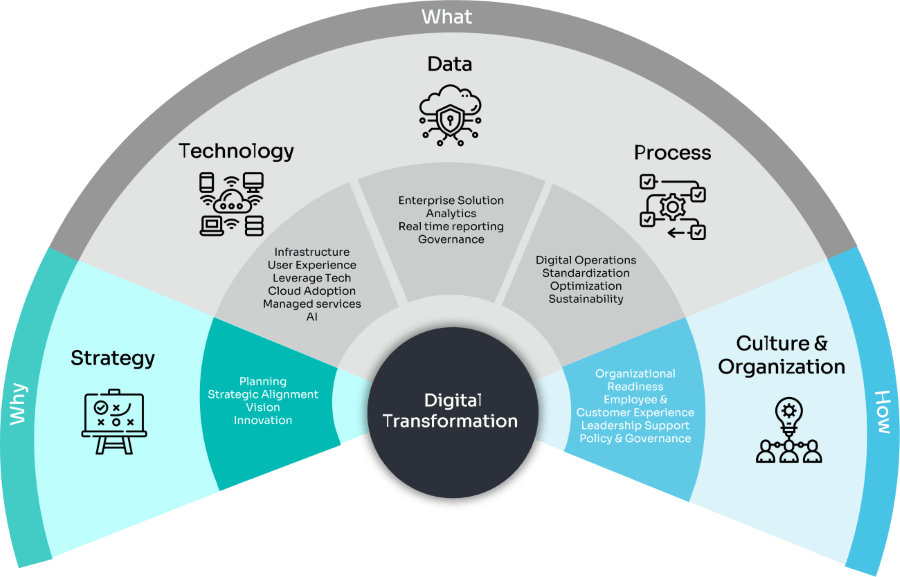
Leading your organization through transformation? Start here.
In today's ever-changing business environment, only 16% of organizations say their digital transformation initiatives have been successful, with most digital transformation efforts failing to achieve the full success they envisioned. This begs the question – what’s going wrong? If organizations are continuing to integrate new technologies, systems and processes to digitize their business models, why are the majority failing to see the long-term success of their digital transformation initiatives?
Although there are many reasons a transformation initiative might not meet intended outcomes, most organizations believe the success of their digital transformation is solely dependent on selecting and implementing the correct technologies, systems or processes. In reality, insight into problems related to leadership, company culture and organizational structure reveal underlying issues that can drastically affect the overall success of the initiative.
The people aspect of transformation
To increase the likelihood of success, organizations looking to transform their business operations should be intentional in focusing on the people aspect of their transformation, as people are more willing to support a change they helped create. But bringing your organization’s people to the center of the conversation to guide pivotal business decisions is only the first step in successfully leading your organization through change.
The second is the acknowledgment that change is a never-ending reality, not only in the workplace but in your employees’ personal lives as well. There are plenty of external factors with the potential to place obstacles in the way of progress; combined with internal challenges, it can be difficult for your people to accept and navigate more change. As we’re all experiencing change constantly, it’s important to be understanding of the amount of change your people are dealing with daily and lead them with some level of empathy. If you're planning on introducing a major transformation, it's especially important to understand your people’s current change environment and to be intentional about how you plan to lead them through the change, or risk encountering change fatigue later down the line.
Change fatigue – the exhaustion people feel when continuously exposed to high volumes of change in a short time period – can occur when organizations implement a series of transformation initiatives without giving their people adequate time to adapt and fully integrate those changes into their work processes. This can pose a significant barrier to digital transformation success as it often leads to resistance, apathy and disengagement of your people – who are critical to its success. Therefore, it is essential for leadership to be intentional in managing change fatigue by providing adequate support and communication to their people to create a positive and supportive environment.
The constant change in your employees' lives will never stop. Leading transformation initiatives with a transformative mentality will allow your people to be better prepared to respond to whatever might happen in your organization. It allows for more flexibility, adaptability and agility in your day-to-day operations, becoming an essential aspect to the survival of your organization.
Establishing a transformative mentality
While digital transformations fail for various reasons, the most common causes derive from an organization's inability to approach change from a holistic viewpoint. To successfully transform your organization, everyone must begin to think differently about change, regardless of their role in the organization’s overall structure.
The graphic below outlines how your organization can begin to transition from a passive approach of simply managing change, to actively leading change through empowering people to own and be accountable for the success of the transformation. Your organization can begin to move towards leading change as you work to build an aptitude for change and install a more collaborative culture throughout your organization.

True transformation requires that everyone operates with a mentality driven by a culture of change – the belief that change itself is not enough and that your success is derived from a shared organizational vision. When everyone in your organization is operating from a transformative mentality, it positively impacts agility and tolerance to change, so that people at all levels, leadership included, are more adaptable.
A transformative mentality is, in its most basic form, a way of thinking that creates an environment that is ready for change. There are three foundational mindsets that work collectively to promote successful digital transformation:
1. Strategic mindset
Regardless of the role you play in your organization, it’s essential to think strategically about how the transformation initiatives will drive your organization forward. Leaders are guided by a vision and use strategy as a map to get there. When beginning any transformation initiative, it’s important to understand what strategies are driving business decisions and then align the vision for the transformation to support those objectives.
A strategic mindset is centered around asking the right questions to further clarify where the organization is headed and what strategies are being used to drive business decisions. Some examples of organizational strategies that might be driving your business include customer experience, employee experience, topline growth, bottom line productivity or increased market share. Leadership will be more willing to support the change when you can create a compelling story that connects the benefits of the change, or the risk to the organization if you don’t change, to your organizational vision.
2. Digital mindset
Once you’ve aligned your vision, you can prepare your organizational culture by establishing a digital mindset across the organization. If your strategy and vision are in place, but people still aren’t buying in, it’s most likely because they don’t understand how technology will help them or why it matters to the business. To achieve success, organizations need to work on shifting its culture to a digital mindset to help everyone across the organization understand how technology helps achieve a goal that benefits them, the company or the customer so that it won't be perceived as a disruption to the business.
Implementing a digital mindset requires an organizational culture that invites everyone to be involved in the digital transformation process. This mindset can be achieved when you focus on two critical areas:
- Generating buy-in around the value of a digital culture
- Designing systems and processes in support of both organizational and business-level goals
When employees from all areas of the business are brought to the forefront of planning and decision making, ownership and accountability for success is established and potential resisters could become early adopters and advocates for the change, creating a collaborative culture that works together to drive transformation.
3. Catalyst mindset
A catalyst mindset allows organizations to continue to maintain a state of change while not losing sight of their purpose, values and mission. In the case of transformation, the rate of change is exponentially increasing and the quest for organizational growth is infinite because every time you institute a change, more change is being created.
Ongoing transformation essentially becomes a catalyst itself for whatever change is coming next for your organization. You have to be willing to commit to navigating both the immediate change, as well as all the downstream impacts created as a result of transformation. Adapting a catalyst mindset sets the table for leaders and managers to think of themselves as an agent of change – someone whose job it is to guide people in a constant state of change.
Start with the why and how
Transformation happens when you set a vision and include the voice of your people in the journey.

When initiating a transformation in your organization, focusing on your strategy and people are critical starting points to ensure success. Suppose you don't have a clear vision of where you're headed. In that case, getting distracted by new technologies, processes and methodologies can lead you to get lost on your path.
Transformation requires that everyone, at every level of your organization, is working together to figure out the best way to integrate change. Ask yourself, “Does your culture support a transformative mentality or are decisions made at the top and simply funneled down?” When you get everyone involved in the transformation process, you can create a culture of open-source change that encourages your people to co-create in the transformation process.
When you bring your people into the conversation at the forefront of strategic initiatives, you invite them to actively participate in the transformation journey, as opposed to being passive recipients of change. For this to happen, they need to understand why transformation is needed, how it will be accomplished and what the transformation means to them. Therefore, successful change leaders begin by defining their desired outcome and aligning their people, strategies and organizational priorities to ensure that everything works in tandem to support the change.
It's important to understand that for your employees, transformation causes uncertainty and disruption to their day-to-day activities. If you fail to begin with a clearly defined vision and alignment to strategy, your people may not understand why the change is needed nor feel inclined to support it. When your people understand how their work supports the organization's mission and goals, they will feel like the transformation has purpose and will actively work to support it. If you clearly define the desired outcomes early in the transformation planning and then bring your people in to help create the path forward, they are more likely to champion the change.
A people-centered approach forward
Baker Tilly's digital team believes that a transformative mentality must be at the center of your organizational culture to successfully compete in your market. Through a people-centered approach to transformation, Baker Tilly's Organizational Readiness framework helps companies harness the power to enhance the path to their ideal future state by leading their people on an end-to-end journey that connects to the organizational mission, vision and priorities.
Contact our team today to learn more about how Baker Tilly can support your company and your people through a successful digital transformation.
This article was derived from the Leading your organization through transformation webinar, watch the full recording below.
Other articles in this series





